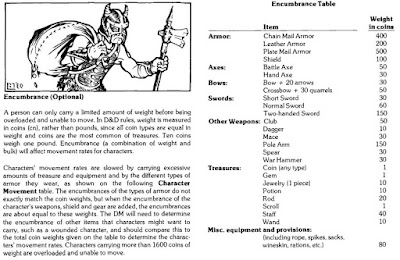I've been thinking about encumbrance recently and the best way to handle it at the table. Like all things D&D related, some amount of abstraction is used as to not have to provide a perfect representation of the world. Lets take a look at a few historical weapons from around the end of the 15th century and how they pair up to the rules provided in B/X.
From the rules in B/X we see that a Dagger should encumber for the same amount as 10 coins, which the rules define as 10 coins to a pound. A Hand Axe is 30 coins (3 pounds) as is the Mace. The Battle Axe is 50 coins (5 pounds), a Spear is 30 coins (3 pounds), and "Pole Arm" covers a huge group and is listed as 150 coins (15 pounds). Chain Mail is 400 coins (40 pounds), Plate Mail comes in at 500 coins (50 pounds), and a Shield being 100 coins (10 pounds). Finally the Normal Sword is 60 coins (6 pounds). At a glance these numbers feel right, but are they?
Dagger, Date 1650–1675, Wt. 14 oz.
Hand Axe, Date 1480–1500, Wt. 1 lb. 7 oz.
Mace, Date 1550, Wt. 3 lb. 1 oz.
Battle Axe, Date 1501–1700, Wt. 3 lb. 14 oz.
Spear, Date 1470–1490, Wt. 5 lb. 11 oz.
Pole Arm, 1600–1625, Wt. 4 lb. 10 oz.
Chain Mail, Date 1550–1575, Wt. 16 lb. 13 oz.
Plate Mail, Date 1587, Wt. 68 lb. 8 oz.
Shield, Date 1580–1610, Wt. 5 lb. 13 oz.
Normal Sword, Date 1500–1533, Wt. 3 lb. 10 oz.
After looking at the examples above, we see that they get it close. Once you round up the 2 oz, the Dagger is right. The Hand Axe comes in around half it's real weight, but the Mace is nearly perfect. A Battle Axe is a pound too heavy, but if the expected weapon had a point or hammer head on the rear it would be much closer. Grouping "Pole Arm" as one is a huge mistake. I included two examples for this, one is a Halberd with a long point and axe head which is what would come to mind for most when they hear Pole Arm while the other example is a Spear with a length of 8 feet just to cover my bases. These both weigh around 5 or 6 pounds but would be three times as much in B/X, and the spear would be half the weight if going by the Spear entry in the book.
Looking at armor needs to be done with more context than the weapons. Surviving historical examples are likely unordinary to be preserved, this is why we have many examples of lavish plate armor but few with patches and battle damage. Also take into account that the Mail Shirt I use as an example is only the shirt, "Mail Armor" likely would include a padded gambeson underneath, or a long shirt reaching to the knees. With these considered, the Chain Mail armor being 40 pounds in B/X isn't terribly wrong. It's close enough I'd consider it rounded to make the math at the table easier as a design choice. Plate Mail on the other hand is 18 pounds lighter than the historical example, but take note the example in question was restored including the helmet. The Shield is reasonable at 10 pounds, but that is the high end of weight for a shield. I cite a shield made of leather and wood, any metals would get the weight up to match the numbers from the book. The only one that is undeniably wrong is the "Normal" Sword. I cite a Hand-and-a-Half sword, with a blade length of 36 inches and an over all length of 48 inches. This is a sword big enough to be used in both hands, but not so big that is must. We still find that the weight from the book is twice what it should be, and looking to other swords for reference doesn't help any. Zweihander (the largest swords from the period) weighed in from 4 to 8 pounds but by the book once again clock in at 150 coins, double the weight. Going any shorter than the sword I cite and we quickly near Dagger territory, giving a Short Sword nowhere to really belong.
B/X Rules Historical Examples, Rounded
Dagger, 10 coins / 1 lb. 1 lb. / 10 coins
Hand Axe, 30 coins / 3 lb. 1 lb. / 10 coins
Mace, 30 coins / 3 lb. 3 lb. / 30 coins
Battle Axe, 50 coins / 5 lb. 4 lb. / 40 coins
Spear, 30 coins / 3 lb. 6 lb. / 60 coins
Pole Arm, 150 coins / 15 lb. 5 lb. / 50 coins
Chain Mail, 400 coins / 40 lb. 17 lb. / 170 coins
Plate Mail, 500 coins / 50 lb. 68 lb. / 680 coins
Shield, 100 coins / 10 lb. 6 lb. / 60 coins
Normal Sword, 60 coins / 6 lb. 4 lb. / 40 coins
All things considered, the numbers are not that far off from real life. As I said at the start of this post, with all things D&D related some amount of abstraction is used. I try to not let historical accuracy get to me and accept that some things can be changed to make for a better time at the table. Except the weight of swords, fix those.
All images sourced below;
https://www.artic.edu/artworks/117133/dagger
https://www.artic.edu/artworks/116946/axe
https://www.artic.edu/artworks/117060/mace
https://www.artic.edu/artworks/116444/berdysh
https://www.artic.edu/artworks/116264/friuli-spear
https://www.artic.edu/artworks/116312/halberd
https://www.artic.edu/artworks/106382/mail-shirt
https://www.metmuseum.org/art/collection/search/35896
https://www.artic.edu/artworks/106400/shield-for-the-bodyguard-of-wolf-dietrich-von-raitenau-prince-archbishop-of-salzburg
https://www.artic.edu/artworks/117093/hand-and-a-half-sword








No comments:
Post a Comment